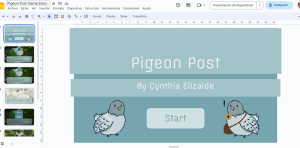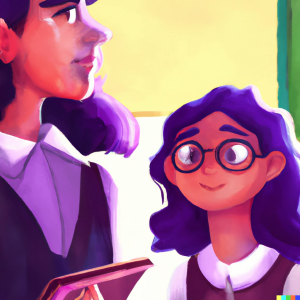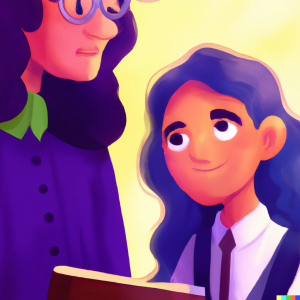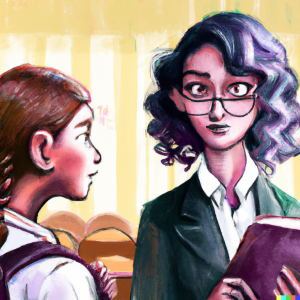Classical Aristotelian 3-part Structure:
A fantasy world, where different creatures live together and have their own rules. There is a community of Fairies that call themselves the “Children of Earth.” They have very strict rules about interacting with outsiders, anyone who isn’t a fairy (animal or plant) is considered not a“Child of Earth.” It is believed that if the fairies have contact with the outsiders they will “contaminate” their bodies, which will damage the purity of Earth. Aniela, one of the few fairies that is training to become a “Child of Earth,” is assigned to take care of one of the many forests in the Fairy community. This one is next to a human village that is isolated from the rest of the human cities.
She encountered humans throughout her training, but she avoided them and never made any close contact. However, she is intrigued by the way they live, their customs, and how they interact with each other. One day there was pure silence coming from the human village, which was rare. Aniela, intrigued, enters the village, she looks everywhere but no humans on sight. That is when, without even noticing, a human child holds her hand. In the moment of panic, she gets paralyzed, knowing perfectly that she has been contaminated by a human. In that moment she stops and analyzes the situation, no one else is there, just the two of them. The child is pale and dirty, which makes Aniela feel concerned about this child’s safety.
At that moment she decided to take care of the human child, she knew that going back will only make things worse, and leaving the child alone will likely not survive. She did not feel remorse, but she questioned her community’s beliefs. Is it okay to let any creature die just because they are not a child of Earth?
Kishontenketsu 4-part Structure:
A group of students that are about to go on a school field trip that is happening up in the mountains. They are visiting the old city of the Sky. It is said that their ancestors would climb these mountains to pray to their guardian angels so that they can be protected from evil and have great health. We are introduced to Uriel, a student who is introverted but would open up to anyone who wants to become friends with him. A bus is taking them to the city of the Sky.
The students enjoy the view from their seats, many chat, many laugh, just a few feeling dizzy from all the curves. Uriel sits next to the most chatty student of the class, she wouldn’t stop talking about the mountains and the old city to Uriel, who did not mind.
Then an accident was caused by another driver taking over both lanes, which caused the bus driver to try and avoid a crash, and that made the bus tilt and fall close to the edge of a hill. Everyone is panicking from the tilt and the injuries. They evacuate the bus, and at the end Uriel leaves the bus together with the girl who was sitting next to him. That is when the hill starts to crack, which makes the bus and the two of them fall down the hill. Is this the end of both of them? Many were thinking that, but Uriel did not panic. He has a special amulet that he can use to summon a guardian angel to save them. But he did not expect the girl that was falling beside him to be a guardian angel.
She saved him and stayed on the side of the hill so no one could see them. Angels can take any form. He keeps it a secret and they wait for the rescue team to arrive.
Episodic Structure:
As the Evergreen Kingdom is under attack, everyone evacuates to get shelter from the neighboring kingdoms.
- A young knight apprentice (squire) from the Evergreen Kingdom evacuated together with her two friends. Incapable of fighting and using a sword, she fears that they would be attacked by the enemy. They walk through the forest to get to the Floreo Kingdom, where they can be safe from the attacks. In this group, she thinks that her two friends are more capable of fighting than her.
- The princess from the Evergreen Kingdom has been evacuated by a special knight from the Floreo Kingdom. This knight is one of the best trained and has the ability to use magic with the help of a flower. They walk through the forest to get as soon as possible to the Floreo Kingdom. The princess is unsure about the idea of going with a knight that’s from another kingdom. It has become a rough situation because the flower won’t stop talking.
- A knight from the Evergreen Kingdom and the Templum Kingdom are on their way to track the princess’ location. They have been sent as a backup to help the princess get to safety, but the attacks have made it difficult for them to find her. They are both acquaintances but have no time for chit chat.
They all meet at some point in the forest on their way to the Floreo Kingdom. That is where they start making plans and strategies to protect the princess, because she is a descendant of the Guardians.
Surrealism Structure:
This is the story of a young man who can enter people’s dreams to escape from his own nightmares. He prefers to watch other people’s dreams so he won’t have to face his terrible nightmares. As time progresses he starts to see those nightmares become reality, which he can’t escape from. He decides to look for a person whose life isn’t a nightmare to live forever in their dreams. As he encounters a College student who is doing well in life, had a lovely childhood, and a supportive family, he decides to stay in his dreams. At first he experiences beautiful moments from these students, but his decision only made this student’s life a nightmare. As he realizes his mistake, he decides to face those nightmares and accept reality.
Personal Anecdote:
This is the story of a little girl from a small town in central Mexico. She was smart, creative, stubborn, selfish, and extroverted. She would think highly of herself because she was better than all the kinds from this small town. The school only had about 70 students in total, and only 8 students her age. First place in any test, contest, and she would receive diplomas or recognition. Everyone would look up to her and follow her as if she was their leader. How did a little girl manage all of that? How can she decide what everyone will play and where she wants to play that game? She did not care if someone got hit by a soccer ball because she was intruding the soccer field. She did not care if someone wanted to play something else because she was the one to choose the game. One day her bubble popped and that is when she realized the harsh reality, she was not the best of the best because there was a world outside her world. There are others better than her, others who are smarter, who are more creative. That day, she became a new person. She understood that it was not easy to survive outside in the real world.











